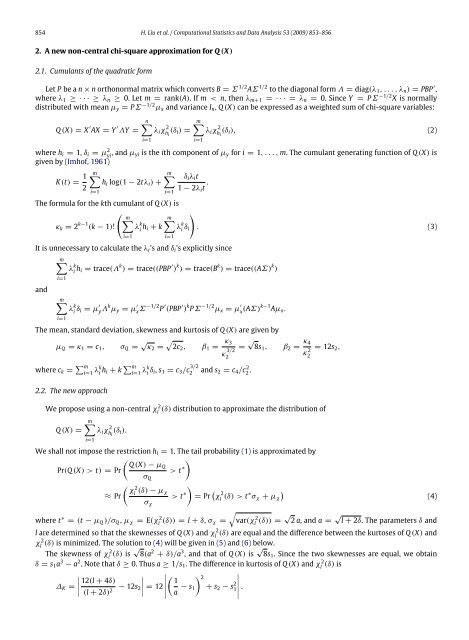A new chi-square approximation to the distribution - NCSU Statistics ...
A new chi-square approximation to the distribution - NCSU Statistics ...
A new chi-square approximation to the distribution - NCSU Statistics ...
You also want an ePaper? Increase the reach of your titles
YUMPU automatically turns print PDFs into web optimized ePapers that Google loves.
854 H. Liu et al. / Computational <strong>Statistics</strong> and Data Analysis 53 (2009) 853–856<br />
2. A <strong>new</strong> non-central <strong>chi</strong>-<strong>square</strong> <strong>approximation</strong> for Q (X)<br />
2.1. Cumulants of <strong>the</strong> quadratic form<br />
Let P be a n × n orthonormal matrix which converts B = Σ 1/2 AΣ 1/2 <strong>to</strong> <strong>the</strong> diagonal form Λ = diag(λ1, . . . , λn) = PBP ′ ,<br />
where λ1 ≥ · · · ≥ λn ≥ 0. Let m = rank(A). If m < n, <strong>the</strong>n λm+1 = · · · = λn = 0. Since Y = PΣ −1/2 X is normally<br />
distributed with mean µy = PΣ −1/2 µx and variance In, Q (X) can be expressed as a weighted sum of <strong>chi</strong>-<strong>square</strong> variables:<br />
Q (X) = X ′ AX = Y ′ ΛY =<br />
n�<br />
i=1<br />
λiχ 2<br />
h i (δi) =<br />
m�<br />
i=1<br />
λiχ 2<br />
h i (δi), (2)<br />
where hi = 1, δi = µ 2<br />
yi , and µyi is <strong>the</strong> ith component of µy for i = 1, . . . , m. The cumulant generating function of Q (X) is<br />
given by (Imhof, 1961)<br />
K(t) = 1<br />
m�<br />
m� δiλit<br />
hi log(1 − 2tλi) +<br />
2<br />
1 − 2λit .<br />
i=1<br />
i=1<br />
The formula for <strong>the</strong> kth cumulant of Q (X) is<br />
κk = 2 k−1 �<br />
m�<br />
(k − 1)! λ k<br />
i hi<br />
m�<br />
+ k<br />
i=1<br />
i=1<br />
λ k<br />
i δi<br />
It is unnecessary <strong>to</strong> calculate <strong>the</strong> λi’s and δi’s explicitly since<br />
m�<br />
λ k<br />
i hi = trace(Λ k ) = trace((PBP ′ ) k ) = trace(B k ) = trace((AΣ) k )<br />
and<br />
i=1<br />
m�<br />
i=1<br />
λ k<br />
i δi = µ ′ y Λk µy = µ ′ x Σ−1/2 P ′ (PBP ′ ) k PΣ −1/2 µx = µ ′ x (AΣ)k−1 Aµx.<br />
The mean, standard deviation, skewness and kur<strong>to</strong>sis of Q (X) are given by<br />
µQ = κ1 = c1, σQ = √ κ2 = � 2c2, β1 = κ3<br />
�<br />
. (3)<br />
κ 3/2<br />
2<br />
where ck = �m i=1 λk<br />
i hi + k �m i=1 λk<br />
i δi, s1 = c3/c 3/2<br />
2 and s2 = c4/c 2<br />
2 .<br />
2.2. The <strong>new</strong> approach<br />
= √ 8s1, β2 = κ4<br />
κ 2 = 12s2,<br />
2<br />
We propose using a non-central χ 2<br />
l (δ) <strong>distribution</strong> <strong>to</strong> approximate <strong>the</strong> <strong>distribution</strong> of<br />
Q (X) =<br />
m�<br />
i=1<br />
λiχ 2<br />
h i (δi).<br />
We shall not impose <strong>the</strong> restriction hi = 1. The tail probability (1) is approximated by<br />
�<br />
Q (X) − µQ<br />
Pr(Q (X) > t) = Pr<br />
> t ∗<br />
�<br />
≈ Pr<br />
σQ<br />
� 2 χl (δ) − µχ<br />
where t ∗ = (t − µQ )/σQ , µχ = E(χ 2<br />
l (δ)) = l + δ, σχ =<br />
l are determined so that <strong>the</strong> skewnesses of Q (X) and χ 2<br />
l<br />
χ 2<br />
l<br />
σχ<br />
> t ∗<br />
�<br />
= Pr � χ 2<br />
l (δ) > t∗ �<br />
σχ + µχ<br />
�<br />
var(χ 2<br />
l (δ)) = √ 2 a, and a = √ l + 2δ. The parameters δ and<br />
(δ) are equal and <strong>the</strong> difference between <strong>the</strong> kur<strong>to</strong>ses of Q (X) and<br />
(δ) is minimized. The solution <strong>to</strong> (4) will be given in (5) and (6) below.<br />
The skewness of χ 2<br />
l (δ) is √ 8(a 2 + δ)/a 3 , and that of Q (X) is √ 8s1. Since <strong>the</strong> two skewnesses are equal, we obtain<br />
δ = s1a 3 − a 2 . Note that δ ≥ 0. Thus a ≥ 1/s1. The difference in kur<strong>to</strong>sis of Q (X) and χ 2<br />
l (δ) is<br />
�<br />
� �<br />
� 12(l<br />
∆K = �<br />
+ 4δ) � ��<br />
�2 � − 12s2<br />
� � 1<br />
(l + 2δ) 2 � = 12 � − s1 + s2 − s<br />
� a 2<br />
�<br />
�<br />
�<br />
1�<br />
� .<br />
(4)
















